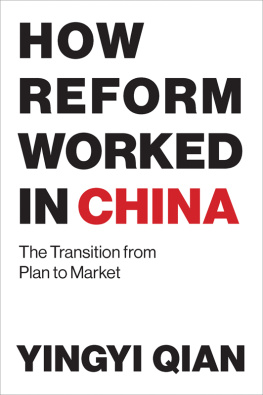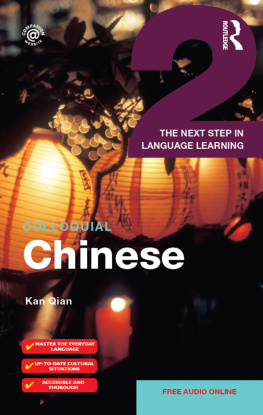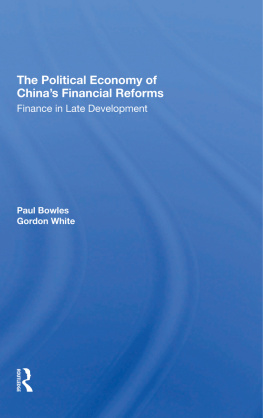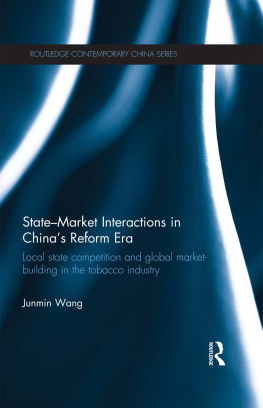
How Reform Worked in China
The Transition from Plan to Market
Yingyi Qian
The MIT Press
Cambridge, Massachusetts
London, England
2017 Massachusetts Institute of Technology
All rights reserved. No part of this book may be reproduced in any form by any electronic or mechanical means (including photocopying, recording, or information storage and retrieval) without permission in writing from the publisher.
This book was set in Palatino LT Std by Toppan Best-set Premedia Limited. Printed and bound in the United States of America.
Library of Congress Cataloging-in-Publication Data
Names: Qian, Yingyi, 1956- author.
Title: How reform worked in China : the transition from plan to market /
Yingyi Qian.
Description: Cambridge, MA : MIT Press, [2017] | Includes bibliographical
references and index.
Identifiers: LCCN 2017007623 | ISBN 9780262534246 (pbk. : alk. paper)
eISBN 9780262342704
Subjects: LCSH: China--Economic policy--2000- | Central planning--China. |
Central-local government relations--China. | Federal government--China. |
Decentralization in government--China. | Mixed economy--China.
Classification: LCC HC427.95 .Q2526 2017 | DDC 338.951--dc23 LC record available at https://lccn.loc.gov/2017007623
ePub Version 1.0
For my parents
Acknowledgments
I am most grateful to my coauthors of the publications included in this book, both for giving me the opportunity to work with them and for allowing me to include these articles in the book. I thank Jiahua Che, Hehui Jin, Lawrence J. Lau, Eric Maskin, Gabriella Montinola, Grard Roland, Barry R. Weingast, and Chenggang Xu for their intellectual inspiration and input in our joint works, and for their valuable comments and suggestions for other articles included in this book.
During the course of research on these projects, I benefited enormously from helpful comments and suggestions from many distinguished colleagues and scholars, especially Philippe Aghion, Alberto Alesina, Takeshi Amemiya, Masahiko Aoki, Kenneth Arrow, Chong-En Bai, Abhijit Banerjee, Pranab Bardhan, Erik Berglof, Patrick Bolton, Bill Evans, Ronald Findlay, Roger Gordon, Avner Greif, Peter Hammond, Oliver Hart, Bengt Holmstrom, Athar Hussain, D. Gale Johnson, Lawrence Katz, Anjini Kochar, Michael Kremer, Anne Krueger, Carla Kruger, Paul Krugman, Jean-Jacques Laffont, Nicholas Lardy, David D. Li, Wei Li, John Litwack, Ronald McKinnon, John McMillan, Dilip Mookherjee, Jonathan Morduch, Peter Murrell, Ramon Myers, Barry Naughton, Roger Noll, Douglass North, Jean Oi, Albert Park, Dwight Perkins, Louis Putterman, Thomas Rawski, Dani Rodrik, Sherwin Rosen, Seth Sanders, Robert Schwab, Anna Seleny, Susan Shirk, William Simon, Pablo Spiller, T. N. Srinivasan, Jan Svejnar, Yijiang Wang, Shang-Jin Wei, Martin Weitzman, David Wildasin, Oliver Williamson, Frank Wolak, Jinglian Wu, Alwyn Young, and Heng-fu Zou.
My interest in China's economic reform started in 1983 when I first met Professor Jinglian Wu at Yale when he was a visiting scholar and I was a graduate student. After I enrolled in the PhD program in economics at Harvard, my academic interest in China's reform deepened. I benefited from several academic mentors during my graduate studies at Harvard; among them, Janos Kornai gave me insights on reform in Eastern European and the Soviet Union, Dwight Perkins guided me toward learning about China from a historical perspective, and Eric Maskin taught me how to use modern economic tools such as game theory to analyze reform problems.
Since 1990, when I joined the economics faculty at Stanford, research on China's reform has become my professional pursuit. Almost all of the articles contained in this book were completed or initiated when I was at Stanford. I am most grateful to my Stanford colleagues Masahiko Aoki, Lawrence J. Lau, Ronald McKinnon, Paul Milgrom, and Joseph Stiglitz for their consistent encouragement and support for my research on China. Outside of Stanford, many gave me intellectual stimulation and support for my research, and I am especially grateful to Oliver Hart, Janos Kornai, Jean-Jacques Laffont, Eric Maskin, Douglass North, Dani Rodrik, Andrei Shleifer, and Oliver Williamson. They may disagree with each other, and we may have different opinions, but they are never short of intellectual depth and challenges.
I have been fortunate to be a faculty member of three universitiesStanford University, the University of Maryland, and the University of California at Berkeleythat provided excellent academic environments as well as financial support for the research on the chapters in this book. I am also grateful to the School of Economics and Management at Tsinghua University in Beijing, where I am currently a faculty member and the dean.
Finally, I would like to thank the dedicated team at the MIT Press, starting with John S. Covell and after his retirement continuing with Jane A. Macdonald and Emily Taber in the acquisitions department and Virginia Crossman in the editorial department, for their dedicated work in making this book possible.
Introduction: A New Perspective on Reform
1.The Success of Chinas Economic Reform
Starting in 1979, China embarked on a profound economic reform that led to a transformation of the country from a centrally planned economy to a market economy. Over the next 37 years, China produced one of the most spectacular growth records in human history. According to the World Bank, in 2015 the nominal GDP of China was nearly $11 trillion, surpassing 60 percent of U.S. nominal GDP. In comparison, Chinas nominal GDP in 1978 was only $148 billion, merely 6 percent of that of the U.S. If measured by Purchasing Power Parity (PPP), in 2015 Chinas GDP was $19 trillion, larger than the $18 trillion GDP of the U.S., the worlds largest economy in the last 100 years. The global market took note of the rise of the Chinese economy and in 2015 witnessed two symbolic events: the significant impact of Chinas exchange rate movements on U.S. markets in August, and the notable effects of the U.S. interest rate rise on Chinese capital flows in December. For China and the world, 2015 was a year to remember.
At least one economist had actually predicted such an outcome twenty years earlier. Angus Maddison (1998) predicted in the late 1990s that China would overtake the U.S. in total GDP by 2015, as measured by PPP. Written in 2000, my article How Reform Worked in China (chapter 1 in this book) contains the following simple condition under which Maddisons prediction would make sense: China needed to grow 4 percentage points faster than the U.S. annually from 1995 to 2015 (see chapter 1, note 1). This is exactly what happened. Although this outcome was not a surprise to Maddison, it exceeded the expectations of most economists.
Of course, Chinas per capita GDP is still not high. In 2015, Chinas per capita GDP was $7,925 on the nominal term, about 1/7 that of the U.S. It was $14,239 as measured by PPP, or one quarter of that of the U.S.
2015 also marked the slowdown of Chinese economic growth when, for the first time since 1991, Chinas growth rate fell below 7 percent. The year was a turning point, not only because China reached 60 percent of U.S. GDP in the nominal term and overtook the U.S. as the largest economy in the PPP term, but also because Chinas economic growth was entering a new era. In the coming decades, China faces new challenges, partly due to the nature of its new middle-income status: China is a lot richer than it was before. It is also partly due to the costs China has paid to achieve such rapid growth, including negative effects on the environment, an increase in inequality, wasteful investment, excess capacity, high leverages, unfunded social mandates, and its financial risks. On top of that, its demography has shifted and its population is getting older. In 2014, the share of the population aged 60 or older stood at 15.53 percent, while the population aged 65 or older was 10.06 percent. The share of the population aged 1559 (i.e., those in the labor force) has been declining in absolute number since 2012.
Next page








